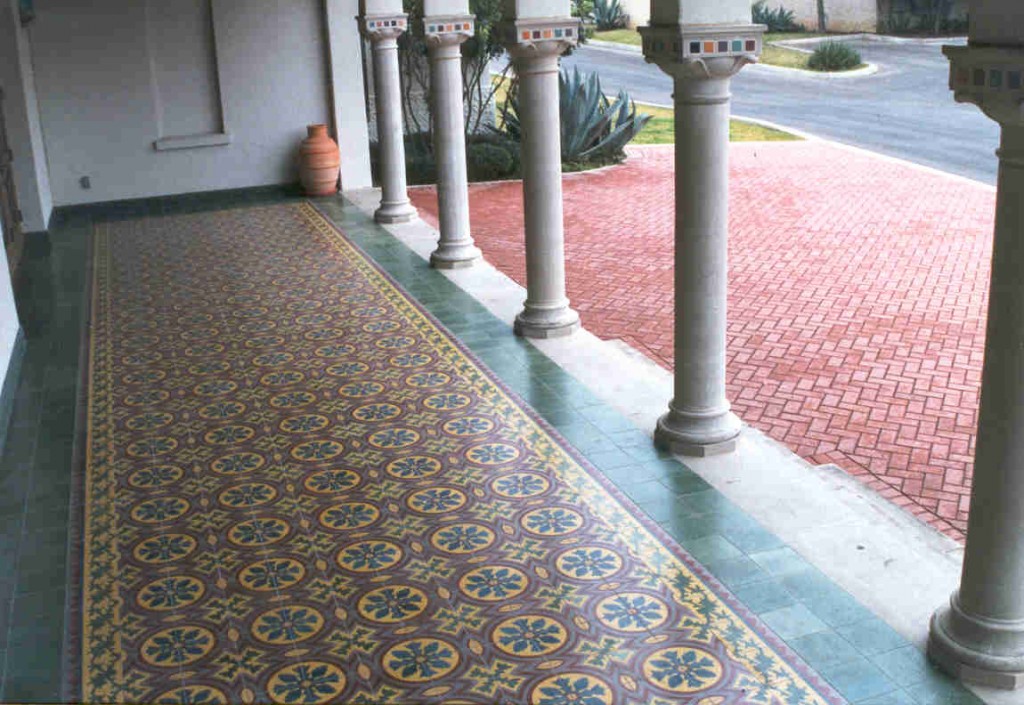
Thi công lắp gạch bông
PRECAUTIONS
- Encaustic tiles have nuances in design and colour. All tiles will not be identical. This is a result of the hand-crafted production process and the nature of cement. Mixing tiles from different boxes during setting is suggested to produce a beautiful naturally rich appearance
- The tiles are unsealed raw cement. They can be easily stained until they are appropriately sealed. Try to avoid walking on the raw tiles or handling with dirty hands. In between procedures, protect the tiles from foot traffic. If walking on the tiles is essential, then we would recommend covering with cardboard (as opposed to plastic which inhibits drying).
- Always test sealing products on a single tile before applying to the entire floor.
- Do not make unnecessary pencil marks on the tiles as they may be impossible to remove after.
- Tiles will expand and contract in different temperatures. We recommend the use of DITRA matting or a similar product and/or expansion joints to prevent any cracking in your tiles.
- If you are tiling any surfaces that will be coming into direct contact with water you must ensure that the substrate is absolutely waterproof, especially if it is sensitive to water like wood or plaster.
- Because of the delicate, porous nature of these tiles, we recommend that all the tiles are sealed prior to fixing and allowed 24 hours to cure to assist with keeping the tiles clean during the fixing process.
NB the tile should be clean and dry before applying any sealant.
- We also recommend the use of rapid setting adhesive to minimize water-absorption through the back of the tile.
LAYOUT
- Before installation, lay out at least one row of tiles (without adhesive) in each direction to see if any adjustments need to be made. You may need to shift the layout to balance the border tiles from the wall.
- Mark guidelines using a chalk line to suit your layout.
FIXING THE TILES
- Prepare a level floor surface with concrete or self-levelling cement – please consult an experienced tiling professional if laying onto a wooden floor as this kind of substrate may be subject to movement and/or deformation.
- Ensure that the substrate is dry so that there is no danger of humidity evaporating through the tiles which can leave traces of nitrate.
- Examine all tiles for damage.
- Prepare the adhesive following manufacture guidelines.
- Unsealed cement is very absorbent so PRE-WETTING THE BACK SIDE OF THE TILES PRIOR TO SETTING is required. Briefly dip the tiles in water (1-3 seconds) and let the excess drip away. Avoid letting the tiles sit in water for long periods.
- Spread the adhesive on the surface to be tiled using a notched trowel, working in areas of 0.2 – 0.5m2. Also apply adhesive to the back of the tile. Make sure that the whole surface of the tile is in contact with the adhesive.
- Carefully hand-press each tile. DO NOT USE A HAMMER OR RUBBER MALLET as this can cause micro-cracks to appear or even break the tile.
- Lay the tiles almost edge to edge with as narrow a grout line as possible (traditionally 1mm). Generally, cement tiles are set abutted to one another with a small grout line. The only exception is for outdoor use or designs where a client may prefer a wider grout joint. In our opinion, the finer the joint, the more elegant the result.
- Adjust each tile in relation to each other to maintain levels taking care to align them correctly, following your chalk line guide.
WE DO NOT RECOMMEND THE PLACEMENT OF THESE TILES ONTO FRESH MORTAR OR COMPACTED SAND-CEMENT AS THIS WILL ALMOST ALWAYS RESULT IN UNEVEN TILES WHICH WILL EVENTUALLY COME LOOSE OR CRACK.
- Avoid getting adhesive on the surface of the tile as this can lead to staining.
- Once set, leave the tiles to stand for 12-15 hours until dry.
PREPARATION BEFORE 1st COAT OF SEALANT
- Once the adhesive has cured, check the tiles for any surface dirt or dried adhesive, removing any blemishes with a razor blade or lightly sanding with waterproof sandpaper (No. 600), taking care not to scratch the surface. DO NOT USE ACID, VINIGAR OR BLEACH.
- ALLOW TILES TO DRY COMPLETELY. If the tiles are sealed or waxed when wet it can result in ‘ghosting’ under the sealant and can impede evaporation.
- Whilst the tiles are drying, protect the tiles from all foot traffic.
SEALING – 1st COAT
- Make sure that the tiles are completely dry (at least 24 hours after having been set) and that they are completely clean before applying the first coat of sealant (we recommend Lithofin Stainstop MN).
- Apply the sealant as per manufacturer’s guidelines. (NB Some tiles are more porous than others – test the sealant as a first coat on a spare tile.)
- Protect the tiles from foot traffic whilst the sealant is drying (minimum 24 hours)
GROUTING
- IMPORTANT: Do not use dark tinted grout. This can stain your tiles. Test your grout first on a spare tile.
- BEFORE grouting, make sure that the sealant has cured completely.
- Mix the grout to a slightly runny consistency.
- Apply the grout over square metre areas using a grout float or squeegee. Repeat in 30 minutes if using a very thing consistency.
- Clean off excess from the face of the tile using a soft sponge and water. Avoid removing inset grout by wiping across the tile at an angle to the grout line.
- Leave the grout to dry for a minimum of 24 hours.
SEALING – 2nd COAT
- After the grout has dried, make sure that the tiles are completely clean and free from any grout residue.
- Apply the second coat of sealant, taking care to ensure that you wipe away any excess. The best finish is achieved by applying the sealant in small amounts.
- Protect the tiles from foot traffic whilst the second coat is drying (minimum 24 hours)
OPTIONAL 3rd COAT of SEALANT
- If you have been using Lithofin Stainstop MN as the impregnator/ sealant for this tile, we also recommend the use of Lithofin Multiseal as a final top coat. This sealant will give the tile a slight satin sheen but it will greatly assist in keeping the tiles clean for regular maintenance. Apply as per manufacturer’s guidelines.
Please note, the above is intended for guidance only and the ultimate responsibility for laying these tiles remains with the tiler. We cannot accept any responsibility for any issues arising from the incorrect placement of these tiles as a result of this guidance.

